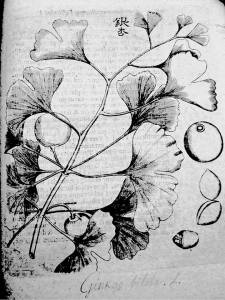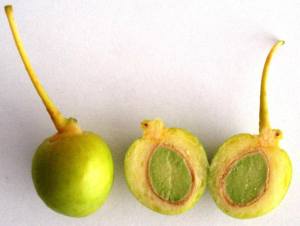By Pedro Jordano with excerpts from Del Tredici (1989) and Crane (2013). Illustrations: WikiMedia.
There are only five living groups of seed plants, and ginkgo is one of them; just a single species. The extant ginkgoes (Ginkgo biloba, Ginkgoaceae) have fleshy “fruits” and their “seeds” were dispersed by animals, including – most probably, from dinosaurs to Pleistocene megafauna, and to extant frugivores nowadays. The reason for this diversity is that the ginkgo has survived on Earth for a really extended period of time, with the earliest fossils dated more than 200 million years ago. Among the many ginkgo-like tree species, only Ginkgo biloba has survived (with up to five ginkgo species known as fossils).

Living ginkgo very nearly went extinct. In fact, two million years ago it existed in only a small area of eastern China, the Tian Mu Shan mountains in Guizhou Province. Ginkgoes have survived only by human intervention, with an assisted dissemination for cultivation starting at least 1200 yr ago by Buddhist monks, and being introduced to Europe only by 1730-1750.
It is most likely that a combination of extreme dispersal limitation due to lack of efficient seed dispersers combined with large-scale climate shifts and habitat modification contributed to their near extinction in the wild. Contrary to other tree species, retractions to small refugia populations failed to recover the original range, especially in North America and Europe. As with other megafauna-dependent species, gingko resprouts vigorously from buds buried in its underground parts, and human use certainly rescued the ginkgoes. In Peter Crane’s words: “It is irrepressible; its capacity for self-preservation has helped it survive through millions of generations.”
 We know very little about how seed dispersal works in living ginkgo. The fleshy “fruit” is really the mature, fertilized ovule with a a three-layered integument: a fleshy outer sarcotesta, a stony inner sclerotesta, and a thin endotesta. Its smelly, large seeds (20-30 mm x 16-24 mm) are one of its most well-known and distinctive features: the seed’s soft outer layer starts to break down after a few days on the ground and produces butyric acid, CH3(CH2)2COOH, giving it the “interesting” odor. Germination improves after the fleshy seed coat has been removed by passing through the gut of an animal. In one of the potentially wild ginkgo populations in China it is documented that the seeds are eaten by a wild cat, and in Japan they are eaten by badgers. Yet, there were very few seedlings in this population, located in 1989 by Del Tredici, despite good fruiting. People harvest the nuts, which are very nutritious, as do Pallas’s squirrels (Callosciurus erythraeus), which also may act as good dispersers by scatter-hoarding the seeds.
We know very little about how seed dispersal works in living ginkgo. The fleshy “fruit” is really the mature, fertilized ovule with a a three-layered integument: a fleshy outer sarcotesta, a stony inner sclerotesta, and a thin endotesta. Its smelly, large seeds (20-30 mm x 16-24 mm) are one of its most well-known and distinctive features: the seed’s soft outer layer starts to break down after a few days on the ground and produces butyric acid, CH3(CH2)2COOH, giving it the “interesting” odor. Germination improves after the fleshy seed coat has been removed by passing through the gut of an animal. In one of the potentially wild ginkgo populations in China it is documented that the seeds are eaten by a wild cat, and in Japan they are eaten by badgers. Yet, there were very few seedlings in this population, located in 1989 by Del Tredici, despite good fruiting. People harvest the nuts, which are very nutritious, as do Pallas’s squirrels (Callosciurus erythraeus), which also may act as good dispersers by scatter-hoarding the seeds.
 Yet who were the seed dispersers that mediated the range expansion of ginkgoes over continents and islands (Japan) before human-mediated propagation? As in other megafauna-dependent plants, it is most likely a combination of dispersal agents, including large and medium-sized mammals and, well before that, dinosaurs. Similar to other extant Coniferopsida like Cephalotaxus and Torreya that have very large seeds, scatter-hoarding animals such as the extinct multituberculates (i.e., the ‘rodents’ of the Mesozoic; G. ptilodus) would have played a role in active seed dispersal of ginkgoes by scatter-hoarding the seeds.
Yet who were the seed dispersers that mediated the range expansion of ginkgoes over continents and islands (Japan) before human-mediated propagation? As in other megafauna-dependent plants, it is most likely a combination of dispersal agents, including large and medium-sized mammals and, well before that, dinosaurs. Similar to other extant Coniferopsida like Cephalotaxus and Torreya that have very large seeds, scatter-hoarding animals such as the extinct multituberculates (i.e., the ‘rodents’ of the Mesozoic; G. ptilodus) would have played a role in active seed dispersal of ginkgoes by scatter-hoarding the seeds.
We can see ginkgoes as survivors with a long history of mutualistic interactions involving a diverse array of animals whose actual diversity we can only speculate about, and which have been replaced by extensive human use.
References
– van Beek, T.A. (2003) Ginkgo biloba. CRC Press, NY.
– Crane, P. (2013). Ginkgo. The tree that time forgot. Yale University Press, New Haven.
– Del Tredici, P. (1989) Ginkgos and multituberculates: evolutionary interactions in the Tertiary. Bio Systems, 22, 327–339.